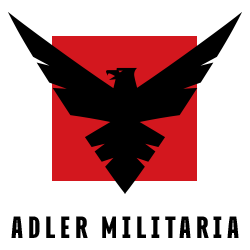Showing 208–216 of 219 resultsSorted by latest
-

WWII German Luftwaffe Soldbuch – Flieger Fritz Krause – Fallschirm-Jäger-Ersatz- und Ausbildungs-Regiment 3 – Late War FJ
$165.00This Soldbuch was issued to Fritz Krause born in 1924, he was drafted into a Luftwaffe replacement unit in late 1944. By 1945 he was in training with Fallschirm-Jäger-Ersatz- und Ausbildungs-Regiment 3 (20 FJD). During the period 4-8 May 1945, the remnants of the 9. Armee, attached to the 12. Armee, crossed to the west bank of the Elbe and surrendered to the U.S. Ninth Army. It would seem he was involved in the last battles although there are not many entries more to follow. A nice example of a late war FJ, who seen the end of the war out he is not listed as KIA.
-

WWII German FW 190 F-8 (931853) “White 7” Engine & Pilot Seat – Schlachtgeschwader 4 – Super Rare Relic of War
This unique and interesting find comes from Latvia in 2023. The pilot was serving with Schlachtgeschwader 4 operating out of Cesis, when the crash happened according to the German Archives (see attached) his body was recovered by the Wehrmacht and buried but his grave is not known exactly where. He was an expereinced pilot with over 60 missions, and both classes of the Iron Cross. As well as the Pilot Clasp with Bronze and Silver. He fought in France, Italy and Russia during the war. More details on the plane and pilot according to Unit archive: 1944-08-22, 1./SG 4, Fw 190 F-8, 931853, 7 weiße, south of Vejava, east of Ergli, Latvia. Pilot Uffz Daleiden, Heribert, + Likely hit by Flak – destroyed 100 %. Shipping: Please note, that these items are in excess of 450 KG but we can put this on a pallet shipped to the UK/EU via courier. For US inquires please send us an email. Price can be discussed, just send us an email.
-

WWII Red Army Soviet Propaganda – For German Soldier – Pass to POW – Bank Note – 23.04.1945 – Rare – Berlin 1945
$39.50A very late pass to surrender to the Red Army, made in the form of a bank note to capture attention. Very late war (23.04.1945) perhaps used during the battle for Berlin 1945.
-
Sale!
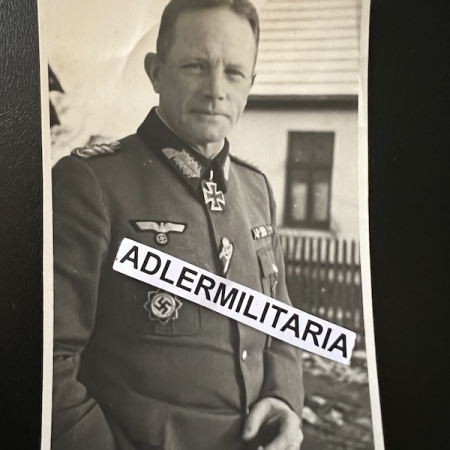
WWII German Photo – Generalleutnant Henze – Dzukste -Kurland 1944 – 21. Feld-Division (L)
$255.00Original price was: $255.00.$155.00Current price is: $155.00.Henze, Albert (Generalleutnant) Date of birth: August 7th, 1894 (Kirchhain/Hesse, Germany) Date of death: March 31st, 1979 (Ingolstadt/Bavaria, Germany) Nationality: German (1933-1945, Third Reich) Biography Promotions: January 27th, 1915: Gefreiter; April 21st, 1915: Unteroffizier; August 2nd, 1915: Vizefeldwebel; March 20th, 1916: Leutnant der Reserve; May 20th, 1920: Leutnant (Polizei); October 21st, 1934: Hauptmann (Reichsheer); January 1st, 1939: Major; December 1st, 1941: Oberstleutnant; April 1st, 1942: Oberst; November 9th, 1944: Generalmajor; May 1st, 1945: Generalleutnant. Ritterkreuz mit Eichenlaub Period: Second World War (1939-1945) Rank: Generalmajor (Brigadier) Unit: Kommandeur, Gruppe Henze, 21. Feld-Division (L), Luftwaffe Awarded on: January 21st, 1945 At the beginning of the battle of Courland, on the 23.12.1944, the Soviets managed to penetrate deeply into the combat area of the 21. Feld-Division (L) south of Dzukste following heavy artillery preparation. On the next day the Soviets continued their attack against the centre of the Division’s front with 6 rifle divisions and the bulk of a tank corps. Recognizing the danger of a breakthrough, Generalmajor Henze ordered a counterattack into the flank of the Soviet assault formation. This counterthrust managed to succeed with the support of Sturmgeschütze, and a new defensive line was formed. Soviet losses amounted to 90 tanks, 3 assault guns and 5 artillery pieces. Henze would receive the Oakleaves for this action. 709th Award.
-

WWII German Photograph – General Leo Geyr von Schweppenburg – Normandy 1944 – Wearing British Dust Glasses – Super Rare Photo
$265.00An amazing photograph, displaying him with dust glasses taken from the British Army. Geyr von Schweppenburg (2 March 1886 – 27 January 1974) was a German general during World War II who is noted for his pioneering stance and expertise in the field of armoured warfare.[2][3] He commanded the 5th Panzer Army (formalised as Panzer Group West) during the Invasion of Normandy, and later served as Inspector General of Armoured Troops. After the war, he was involved in the development of the newly-built German Army (Bundeswehr). Freiherr von Geyr was born in 1886 in Potsdam into the Prussian military aristocracy and descended from a family that had produced two Prussian field marshalls.[4] He joined the German Army in 1904. In World War I, he fought on several fronts and rose to the rank of captain. After the war, he remained in the army, becoming an Oberst in 1932 and a Generalmajor in 1935. From 1933 to 1937, he was a military attaché to the United Kingdom, Belgium and the Netherlands and resided in London. Promoted to Generalleutnant upon his return from London, he took command of the 3rd Panzer (armoured) Division in 1937.[5] World War II From 1 September to 7 October 1939, Geyr commanded the 3rd Panzer Division during the invasion of Poland, where it was the most numerically powerful Panzer Division, with 391 tanks.[6] For a victory at Kulm, he was praised on the battlefield by Hitler, who had visited the division in recognition for its achievements in Poland.[7] He was promoted to General der Kavallerie of the XXIV Panzer Corps on 15 February 1940. In 1940, he commanded the XXIV Panzer Corps in the Invasion of France. In 1941, in the invasion of the Soviet Union, Geyr’s XXIV Panzer Corps was part of General Heinz Guderian’s Second Panzer Army, and consisted of all of Guderian’s major tank units.[8] On 9 July 1941, he was awarded the Knight’s Cross of the Iron Cross as General der Panzertruppe.[9] By early November 1941, Geyr’s Panzer Corps commanded the 3rd, 4th, and 17th Panzer Divisions, the panzer regiment from the 18th Panzer Division, as well as the Infantry Regiment Großdeutschland, and spearheaded the advance of Army Group Centre during the Battle of Moscow.[8] From 21 July 1942, taking over from the court-martialed Georg Stumme,[10] to 30 September 1942, he was commanding General of the XXXX Panzer Corps, taking part in the fighting in the Caucasus. Geyr was relieved in a command cadre shakeup at the end of September 1942.[10] In the spring of 1943, Field Marshal Gerd von Rundstedt ordered Geyr to prepare a force of 10 Panzer and motorised infantry divisions. On 19 November 1943, Geyr’s command was formalised as Panzer Group West, which had responsibility for the training and formation of all armoured units in the west. The group of armoured divisions near Paris constituted the Germans’ main force of tanks in France. In the event of an Allied landing on the northern French coast, Panzer Group West was expected to counterattack northward and to halt the invasion force.[11] The Allied invasion of Normandy took place on 6 June 1944. By 8 June, Geyr had moved three panzer divisions northward against British and Canadian forces advancing on the town of Caen. On, Royal Air Force aircraft attacked his newly-established headquarters at La Caine in Normandy. Geyr was wounded and many of his staff officers were killed, which forced the cancellation of the counterattack.[12] Geyr’s reinforced tank units managed to prevent the British advance for another month, but he was nevertheless relieved of his command on 2 July after seconding Rundstedt’s request for Hitler to authorize a strategic withdrawal from Caen.[13][14][15] He was succeeded by Heinrich Eberbach on 4 July and served as Inspector General of Armoured Troops until the closing phase of the war
-
Sale!

WWII German Knights Cross Holder – Karl-Conrad Mecke – Raid on St Nazaire – 22 Marine Flak Regiment
$225.00Original price was: $225.00.$165.00Current price is: $165.00.An extremely desirable and rare postcard size photograph of Mecke with his Knights Cross, which he won during the British raid on St Nazaire, also known as the Greatest Raid of All. Knights Cross action: Awarded for his role in combating the British raid on St. Nazaire, Operation Chariot, on 28.03.1942. Due to the unusual behaviour of the British bombers it was Mecke who recognized the potential of a landing and put his troops on alert. His guns later opened fire on the British convoy despite their disguise as German vessels and also participated in the fight against the British landing forces.
-
Sale!
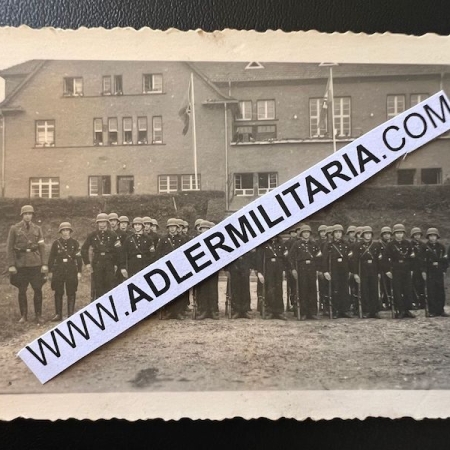
WWII German Photograph – Hitler Youth Bahn 277 – 1945 Danzig – “larger ready for transport to the front” – Issued Rifles
$165.00Original price was: $165.00.$135.00Current price is: $135.00.An extremely rare annotated photograph, depicting Hitler Youth 277 Bahn Ost Ostland. On the rear of the photograph, “Larger fertig zur Abfahrt an der Front” Meaning they are ready for transport to the front. It is unknown what became of these HJ Boys, they were likely thrown in at the end of the war which was not uncommon. Note, they have been issued helmets and Rifles, to the far left a HJ Leader can be seen in Helmet and the far right a HJ wearing a Wehrmacht Visor.
-
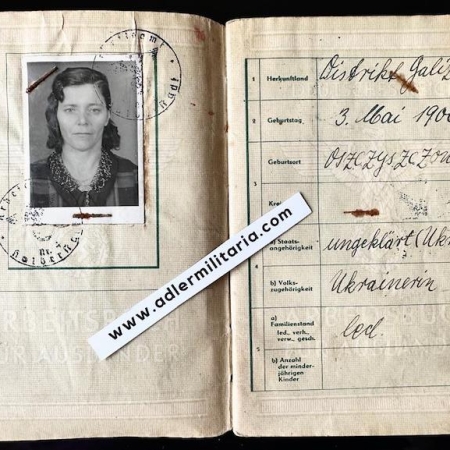
Arbeitsbuch Für Ausländer – Ukrainian Eva Melnyk – From District Galizien
$125.00An interesting Work book with period applied photograph, Melnyk was from Galizien district in Ukraine and arrived in 1942 for work a farm in Germany (Badersleben) where she worked till the wars end.
-
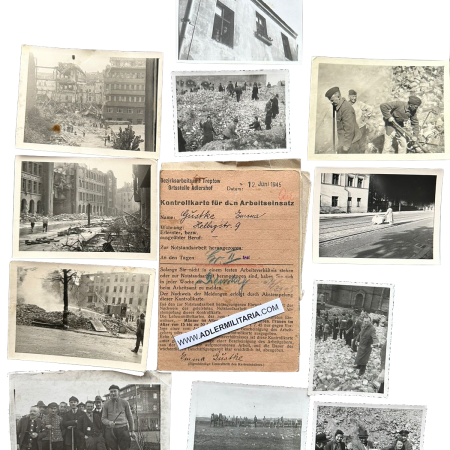
Tümmerfrau- Emma Gustke – Berlin 1945 – Rubble cleaner – Rare grouping
$235.00Tümmerfrau – Berlin in Ruins The Work Control Card and photos of a Trümmerfrau For more information see: https://en.wikipedia.org/wiki/Tr%C3%BCmmerfrau Emma Gustke, from Treptow was employed from the 18th of June 1945 to clean the streets of Berlin. Men from 15 to the age of 65 and woman from the ages of 15 to 50 years old were required to work. Her photos show the extent of the damage, brick by brick the areas were cleared. In Berlin alone around 60,000 woman were employed to clean the streets from the debris the war inflicted on the city. The pictures tucked inside the work card, a few memories she tucked away…
